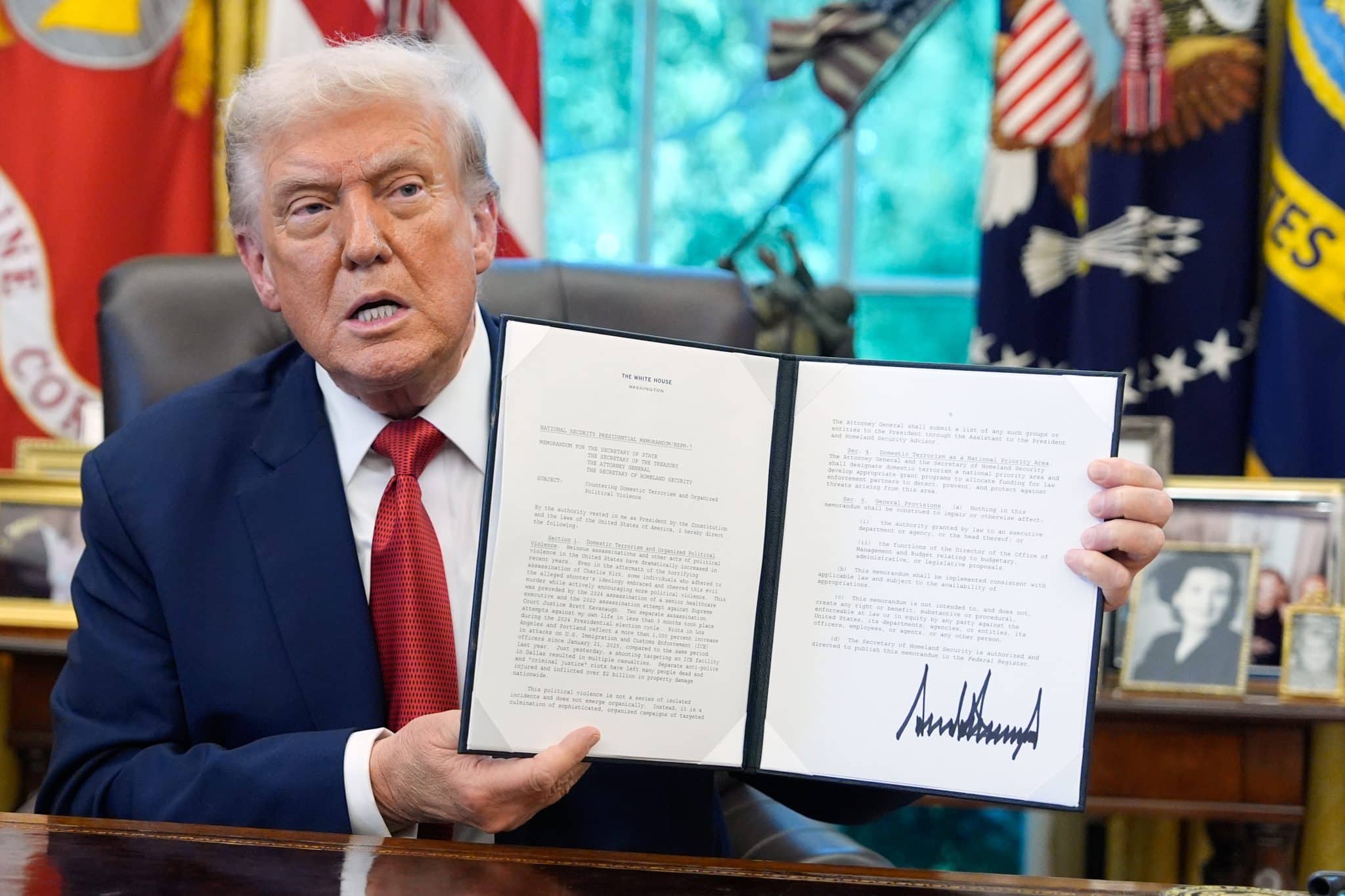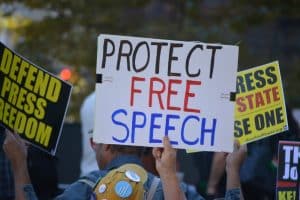The news cycle yesterday was still spinning around Kimmel, and tomorrow it’ll be busy with Comey. But in between came bigger news: the “memo” named in my headline. A “Terror Memo.” I don’t like sending traffic to this White House, but you should read it. In its expansive definition of “terror,” “Countering Domestic Terrorism and Organized Political Violence” may prove to be as much of an acceleration in this slow civil war as the assassination of Charlie Kirk.
I’m no lawyer. Just a journalist, long on the rightwing beat, and an English professor who likes to linger in the luxury of close reading. What follows is my preliminary pass.
First, there’s the form: an executive memo instead of an order. Even as this memo goes into much deeper detail than Monday’s executive order designating an amorphous anything called “antifa” as a “terrorist organization,” the memo, as a form, is looser, free of the need to cite constitutional authority. And yet it retains the “force of law”—perfect for the president who says “it’s not illegal if it saves the country.” And, given what appears to be the vast reallocation of resources called for the Terror Memo, another advantage of the form is that it doesn’t require the Office of Budget and Management to issue a “budgetary impact statement.” What’ll the tab be? Don’t ask. Such questions could, according to the memo, become subject to investigation.
Section 1 lays out the case for action, and from its very first words—”heinous assassinations”—it’s a subtle sleight-of-hand. Note the plural, assassinations. There’s Charlie Kirk, yes. “This was preceded,” the memo continues, “by the 2024 assassination of a senior healthcare executive… the 2022 assassination attempt against Supreme Court Justice Brett Kavanaugh [and] two separate assassination attempts against my own life.” Excluded from the list is the assassination by a politically-motivated Christian nationlist of Democratic Minnesota state legislator Melissa Hortman and her husband, and the attempted murder of state senator John Hoffman his wife. Not all murders matter; but those that do, the memo declares, are a conspiracy hatched by forces far greater than the actual individual gunmen, little fish in whom the the memo shows no interest.
The real enemy, according to the memo, is “organized”:
This political violence is not a series of isolated incidents and does not emerge organically. Instead, it is a culmination of sophisticated, organized campaigns of targeted intimidation, radicalization, threats, and violence designed to silence opposing speech, limit political activity, change or direct policy outcomes, and prevent the functioning of a democratic society. A new law enforcement strategy that investigates all participants in these criminal and terroristic conspiracies — including the organized structures, networks, entities, organizations, funding sources, and predicate actions behind them — is required.
It’s critical to name this bait-&-switch: Using real acts of violence by a handful of unaffiliated individuals to launch an attack on the much greater strength of liberal / left “organized structures, networks, entities, organizations, [and] funding sources.” This isn’t about a manhunt to stop the next murderer before he can shoot; it’s a “new… strategy,” the deconstruction by state power of far less dramatic efforts to build the very step-by-step systemic rule-of-law resistance that is the opposite of violence.
Note the last item on the list: “predicate actions.” What might be the dark “predicate actions” for the donations of liberal billionaires George Soros and Reid Hoffman—both name-checked by Trump Thursday—to efforts such as MoveOn, America Votes, Media Matters, and and peer-to-peer microlending? Capital Research Center, the far right think tank whose “research” the White House is leaning on for the Terror Memo, cites in particular Soros’ support for the Sunrise Movement. Put that next to Trump’s insistence that climate change is a “con job,” and you begin to see how simply naming the facts of fire and flood and heat deaths could come to be construed as “terrorism” subject to investigation.
The memo continues:
These campaigns often begin by isolating and dehumanizing specific targets to justify murder or other violent action against them. They do so through a variety of fora, including anonymous chat forums, in-person meetings, social media, and even educational institutions.
READ: Right-Wing Extremist Violence Is More Frequent and More Deadly Than Left-Wing Violence, Data Shows
The to—as in “to justify murder”—does terrifying work. Grammatically, it makes “murder” the alleged intention of critique. If I taught in my “educational institution” that Trump’s attack on rule-of-law is unprecedented—aka “isolated”—by this memo, I could be accused of justifying murder. This post might be fair game. But probably not! The purpose of such sweeping authority isn’t comprehensive prosecution. Rather, like Article 70 in the Soviet Union, it provides authorities with potential cause to prosecute not everyone but anyone; run afoul of the regime, and there could already be a case against you.
To that end, the memo expands the definition of the enemy from “antifa,” which could at least be said to refer to a confrontational protest style, to “anti-fascist.” Are you pro-fascist? You’re not? You may have a case of anti-fascism. From the Terror Memo:
There are common recurrent motivations and indicia uniting this pattern of violent and terroristic activities under the umbrella of self-described “anti-fascism.” These movements portray foundational American principles (e.g., support for law enforcement and border control) as “fascist” to justify and encourage acts of violent revolution.
Numerous commentators have already noted that “support for law enforcement” can hardly be called foundational to a nation born in rebellion against it, and which took another six-plus decades to muster anything resembling a modern police department. But looking for logic in the aesthetic of fascism is a fool’s errand. Fascism isn’t an argument, it’s an expression of power that sets terms at its own convenience. Per the memo, to even call a cop a “fascist” might be construed as encouraging “acts of violent revolution.”
The Terror Memo’s obsession with “violent revolution” is in part a product of the right’s conflation of the very small communist flank of the U.S. left with the communism of Russia’s 1917 October Revolution. This next clause of the memo, however, more closely mimics the methods Putin used to crush NGO dissent, starting with support for Russian LGBTQ+ organizations by funders such as Soros:
non-governmental organizations and American citizens residing abroad or with close ties to foreign governments, agents, citizens, foundations, or influence networks engaged in violations of the Foreign Agents Registration Act (22 U.S.C. 611 et seq.) or money laundering by funding, creating, or supporting entities that engage in activities that support or encourage domestic terrorism.
This is not to say that Putin is Trump’s puppet master. The fascist moment is global, and the so-called “men of action” learn from each other’s victories in their own attempts to consolidate power.
The following instruction expands the definition of “terrorist acts” from doxing and violent threats—both of which could reasonably construed as such, and both of which have been pursued by powerful regime allies—to include also “trespass” and “civil disorder”:
The Attorney General shall issue specific guidance that ensures domestic terrorism priorities include politically motivated terrorist acts such as organized doxing campaigns, swatting, rioting, looting, trespass, assault, destruction of property, threats of violence, and civil disorder. This guidance shall also include an identification of any behaviors, fact patterns, recurrent motivations, or other indicia common to organizations and entities that coordinate these acts in order to direct efforts to identify and prevent potential violent activity.
These terms bring under the “terrorism” umbrella a nonviolent action as simple as, say, sitting in front of an ICE entrance. Or, for that matter, just chanting from the sidewalk.
Then there’s this instruction:
The [Treasury] Secretary shall provide guidance for financial institutions to file Suspicious Activity Reports and investigate indicia of illicit funding streams to ensure such activity is rooted out at the source and referred for law enforcement action, as appropriate.
Have you ever donated to a left organization with a credit card? Get ready. This doesn’t mean they’re coming for you. It means that if for some reason they want to come for you, you’re already cooked. That little rectangle of plastic in your wallet’s been turned into a weapon to be used against you.
So much of the Terror Memo follows the money:
The Commissioner of the Internal Revenue Service (Commissioner) shall take action to ensure that no tax-exempt entities are directly or indirectly financing political violence or domestic terrorism. In addition, where applicable, the Commissioner shall ensure that the Internal Revenue Service refers such organizations, and the employees and officers of such organizations, to the Department of Justice for investigation and possible prosecution.
The plan isn’t so much to kick down doors as to bleed nonprofits dry, a double whammy effect: as the big organizations dwindle, everyday people doubt the potential of organization. Wonks will realize how it works; others will conclude that maybe such efforts to build democracy just aren’t popular. Some will retreat into alienation; others will persuade themselves to get with the new program.
And for those who carry on the fight?
All Federal law enforcement agencies with investigative authority shall question and interrogate, within all lawful authorities, individuals engaged in political violence or lawlessness regarding the entity or individual organizing such actions and any related financial sponsorship of those actions prior to adjudication or initiation of a plea agreement.
Interrogation, for the purpose of naming names, before any adjudication. How long before the post 9/11 War on Terror’s “enhanced interrogation techniques” get their own new presidential memo?
Investigations should prioritize crimes such as the following: assaulting Federal officers or employees or otherwise engaging in conduct proscribed by 18 U.S.C. 111; conspiracy against rights under 18 U.S.C. 241; conspiracy to commit offense under 18 U.S.C. 371; solicitation to commit a crime of violence under 18 U.S.C. 373; money laundering under 18 U.S.C. 1956; funding of terrorist acts or otherwise facilitating terrorism under 18 U.S.C. 2339, 2339A, 2339B, 2339C, and 2339D; arson offenses under 18 U.S.C. 844; violations of the Racketeer Influenced and Corrupt Organizations Act (18 U.S.C. 1961 et seq.); and major fraud against the United States under 18 U.S.C. 1031.
Slow civil war is just that, slow; and then fascism hiccups, and it jolts ahead. Read the whole terror memo. Read about the indictment of Comey. Consider the generals, summoned by our Secretary of War for what purpose we don’t know. Read this passage. Note what’s now called “terror,” trespass, civil disorder, predicate action. And what “funding” it means.
In the course of and as a result of the investigations directed by section 2 of this memorandum, the Attorney General may recommend that any group or entity whose members are engaged in activities meeting the definition of “domestic terrorism” in 18 U.S.C. 2331(5) merits designation as a “domestic terrorist organization.”
“How long,” writes a friend—I’ll him M., a well-published writer with a federal-adjacent position currently under White House scrutiny—”before they declare the Democratic Party a terror-supporting organization?” Oh, it’s not so bad, I replied. If it came to that it’d probably be just a few state level parties. Shots across the bow. The rest would fall in line.
If not?
The Attorney General and the Secretary of Homeland Security shall designate domestic terrorism a national priority area and develop appropriate grant programs to allocate funding for law enforcement partners to detect, prevent, and protect against threats arising from this area.
This reads as a nearly open promise of payments to local police departments to jump on the bandwagon, to “uncover” local “terrorist” cells.
“A theory I do not voice publicly,” wrote M., “is that J6 was like 9/11 in the sense of it being far more destabilizingly successful than even its architects could have hoped or imagined.”
I wrote another friend, journalist Sandhya Dirks, also a student of the increments by which fascism takes hold (and the means by which we can resist its advances). “i think it’s a red scare,” she replied, “supercharged with post-9/11 systems. i have been thinking / trying to write about the language of the far right,” the way it has seized so much of the vernacular of civil rights. “And also this ‘rubber glue’ rhetoric”—”I’m like rubber, you’re like glue”—”(describing the right’s stochastic terrorism and very real violence as if it’s happening to them, rather than what they are doing)… it’s now the moment when that rhetoric becomes policy, law, rhetoric fully backed by power.”
“Rubber glue fascism.”
I’ve been sitting here for awhile now, trying to think of some way to bend this post toward some thin edge of hope. I don’t have a happy ending. I don’t really have an ending at all. Maybe that can stand in for good news: this bad news isn’t yet the end.
This article was originally published in the Substack newsletter Scenes from a Slow Civil War and is republished here with permission.






